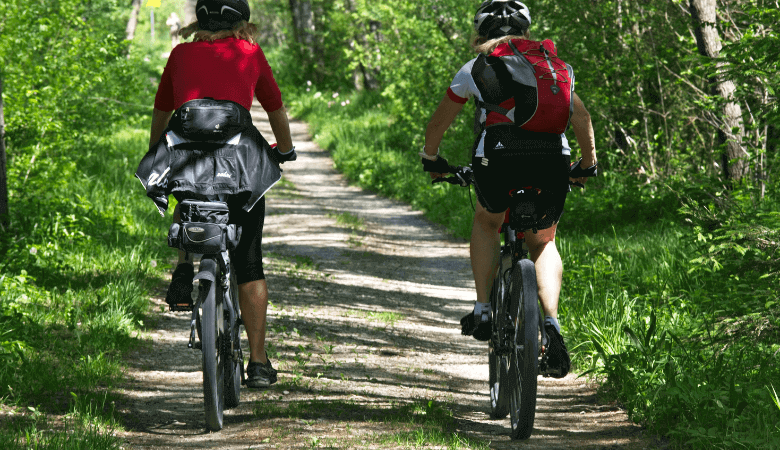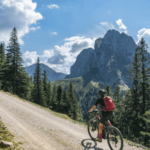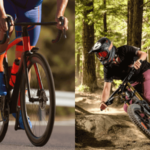There are a few things that mountain bikers can do to make their sport more sustainable. One is to ride bikes that are made with sustainable materials, such as bamboo. Another is to avoid riding in areas that are sensitive to environmental impacts, such as fragile ecosystems or protected areas.
Finally, mountain bikers can support organizations that work to promote sustainable mountain biking practices.
- Advocate for more trails: Mountain biking is only as sustainable as the trails that we have to ride on
- More trails mean more places to ride and less impact on any one area
- You can advocate for new trails by writing letters, attending public meetings, and donating to trail-building organizations
- Ride Responsibly: Be considerate of other trail users and ride within your abilities
- Stick to established trails and don’t create new ones
- By riding responsibly, we can help preserve access to trails for everyone
- Volunteer: Volunteer your time to help maintain existing trails or build new ones
- Giving back not only helps the trail system, but it’s also a great way to meet other mountain bikers and get involved in the community
Sustainable Mountain Biking
Mountain biking is an increasingly popular activity, enjoyed by people of all ages and abilities. Unfortunately, it can also be a very damaging activity to the environment. The construction of new mountain bike trails often requires the clear-cutting of trees and vegetation, which can lead to erosion and soil loss.
The use of mechanized equipment such as excavators and bulldozers can further damage fragile ecosystems. Once built, mountain bike trails are often used excessively, leading to further degradation. For example, riders may create shortcuts that bypass switchbacks, widening the trail and causing accelerated erosion.
In addition, careless riding can result in ruts and gullies forming on the trail surface. To help mitigate these impacts, mountain bikers need to be aware of their responsibility to ride sustainably. Here are some tips:
1) Stick to existing trails as much as possible – don’t create new ones! If you do need to build a new trail, make sure you follow best practices for sustainable trail design and construction (you can find more information on this online or from your local land management agency).
2) Ride responsibly – stay on the trail at all times, avoid creating shortcuts, don’t skid or brake excessively (which causes ruts), yield to uphill traffic, etc. In short: treat the trails with respect!
Beginner Mountain Bike
If you’re looking for a great beginner mountain bike, there are a few things you should keep in mind. First, you’ll want to find a bike that’s the right size for you. Mountain bikes come in all different sizes, so it’s important to find one that’s comfortable for you to ride.
You’ll also want to find a bike with suspension forks. This will help absorb some of the bumps and jarring as you’re riding over rough terrain. Finally, make sure to get a bike with good brakes. You don’t want to be flying down a hill and not be able to stop! If you keep these things in mind, you’re sure to find the perfect beginner mountain bike for you.
Mountain Biking near Me
Mountain biking is one of the best ways to explore the great outdoors. And, luckily, there are plenty of mountain biking trails near me. Here are just a few of the best:
The White Rim Trail in Canyonlands National Park is a must-ride for any mountain biker. The trail winds through red rock canyons and offers amazing views of the surrounding desert landscape. For a longer ride, check out the Kokopelli Trail in Colorado.
This 140-mile trail takes you through high desert terrain and stunning red rock canyon country. If you’re looking for an easier ride, try the Elk Meadows Loop near Salt Lake City, Utah. This short loop is perfect for beginners or anyone who wants to take in some beautiful scenery without too much effort. No matter what your skill level, there’s a mountain bike trail near me that’s perfect for you. So get out there and explore!
Sustainable Mountain Biking: a Case Study from the Southwest of Western Australia
Since the early 1990s, mountain biking has become a popular recreation and sport in southwest Western Australia. The area’s rugged terrain, diverse vegetation, and well-developed trail network make it an ideal destination for mountain bikers. However, the popularity of mountain biking has also had some negative impacts on the environment.
In recent years, there have been increasing concerns about the sustainability of mountain biking in the region. There are a number of environmental issues associated with mountain biking, including trail erosion, damage to vegetation, and soil compaction. These problems can lead to a significant impact on native flora and fauna, as well as decreased water quality and quantity in nearby waterways.
In response to these concerns, a number of initiatives have been implemented in an attempt to make mountain biking more sustainable in southwest Western Australia. One such initiative is the development of ‘trail hubs’. These are central locations where riders can park their cars and access a variety of different trails.
Concentrating rider activity at specific locations reduces vehicle traffic and associated pollution in sensitive areas. It also helps to limit trail damage by reducing the number of different trails being used. Another initiative that has been implemented is the use of ‘no-go’ zones during certain times of the year when native plants are flowering or animals are breeding.
This helps to protect fragile ecosystems from being damaged by bike wheels or overuse. Mountain bikers are also encouraged to stick to designated trails where possible, which helps reduce the further impact on the environment. Overall, there have been positive steps taken towards making mountain biking more sustainable in southwest Western Australia.
Best Beginner Mountain Bike
Mountain biking is a great way to get outdoors and enjoy the scenery. However, before you head out on your first mountain bike ride, there are a few things you should know. Here is a beginner’s guide to mountain biking to help you get started.
First, you will need to choose the right bike. There are different types of mountain bikes available, so it is important to select one that is best suited for your riding style and the terrain you will be riding on. If you are unsure which type of bike to get, consult with a local bike shop or do some research online.
Once you have selected the right bike, it is time to start planning your route. If you are new to mountain biking, it is best to stick to trails that are well-marked and not too challenging. You can find information about trails in your area online or by talking to other cyclists.
When planning your route, be sure to take into account the difficulty of the trail as well as how long it will take you to complete it. Once you have planned your route, make sure you have all the necessary gear before heading out. This includes a helmet, water bottle, and snacks. Now that you are prepared for your first mountain bike ride, go out and enjoy!
Downhill Mountain Bike
When it comes to downhill mountain biking, there are a few things you need to know in order to get started. For one, you need to have a bike that is specifically designed for downhill riding. This means that your bike needs to be able to handle the rough terrain and be durable enough to withstand the challenges of downhill riding.
Additionally, you need to be prepared mentally and physically for the challenges ahead. Downhill mountain biking can be an intense and exhilarating experience, but it can also be dangerous if you’re not careful. Before heading out on your first ride, make sure you do some research and understand the risks involved. With the proper preparation, however, downhill mountain biking can be an incredibly rewarding experience.
How Can I Make My Mountain Bike More Efficient?
There are a few things you can do to make your mountain bike more efficient. First, you can upgrade your tires to something with less rolling resistance. Second, you can make sure your chain is properly lubricated.
Third, you can invest in a lighter-weight bicycle. Fourth, you can keep your bike clean and free of dirt and debris. Fifth, you can use a higher gear when pedaling uphill and a lower gear when going downhill. By following these tips, you will be able to improve the efficiency of your mountain bike.
Is Mountain Biking Good for the Environment?
Mountain biking is often thought of as an environmentally friendly activity. After all, it doesn’t require any fossil fuels and it helps you stay fit and healthy. But there is a downside to mountain biking – it can damage the environment.
Mountain biking can cause soil erosion. When bikes ride over dirt paths, their tires loosen the soil. This can cause rain or snowmelt to wash away the top layer of soil, revealing the underlying rocks and roots.
This process is called “rutting” and it makes trails more difficult to ride on and causes them to degrade over time. Mountain biking can also disturb wildlife habitats. When bikes ride through forests or other natural areas, they scare away animals that live there.
This can disrupt the animals’ feeding and mating habits and ultimately lead to fewer births and less genetic diversity in populations. In some cases, mountain biking has even been linked to habitat destruction, as riders build new trails in previously undeveloped areas. So while mountain biking has some benefits for the environment, it also has some drawbacks that should be considered before hitting the trail.
How is Riding a Bike Sustainable?
Riding a bike is one of the most sustainable methods of transportation. It emits no pollutants, requires no fossil fuels, and has a very small carbon footprint. Additionally, it is an extremely efficient mode of transportation – much more so than walking or taking public transit.
And, bikes are relatively inexpensive to purchase and maintain. Of course, there are some drawbacks to riding a bike. It can be dangerous if you don’t take proper safety precautions (wearing a helmet, using lights at night, etc.), and it can be difficult to ride in inclement weather. But overall, biking is a very sustainable way to get around.
What are the Disadvantages of Mountain Biking?
Mountain biking can be a great way to get outdoors and enjoy the scenery, but there are some disadvantages to consider before you head out on your next trail. Here are a few of the potential drawbacks of mountain biking:
1. Mountain biking can be hard on your body. If you’re not used to riding a bike, or if you haven’t been on one in a while, mountain biking can be tough on your muscles and joints. You might experience soreness after a ride, or even injuries if you fall off your bike.
2. Mountain biking can also be tough on your bike. The rough terrain can put wear and tear on your tires, brakes, and other parts of your bike. You might need to replace parts more often than if you rode on smoother surfaces.
3. Mountain biking takes time and effort to learn how to do it well. Unless you already know how to ride a bike and have some experience with off-road riding, expect to spend some time learning the ropes before you feel comfortable hitting the trails alone.
Conclusion
Mountain biking is a great way to get outside and enjoy the scenery, but it can also be hard on the environment. Here are some tips to make your mountain biking more sustainable:
1. Choose trails that are already established and avoid creating new ones.
2. Ride only when the trail is dry to avoid damaging it.
3. Be considerate of other users of the trail and yield to hikers and equestrians.









1 thought on “How To Make Mountain Biking More Sustainable”